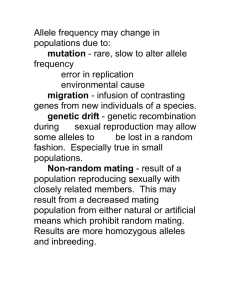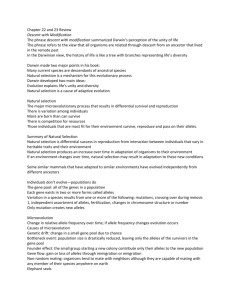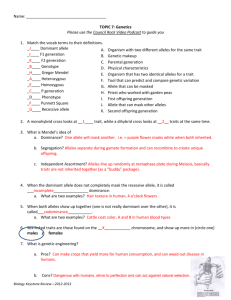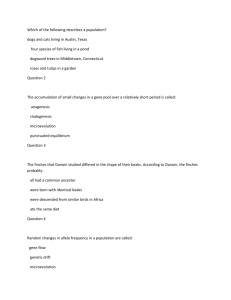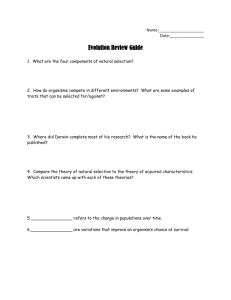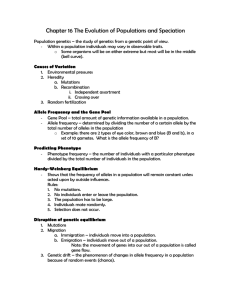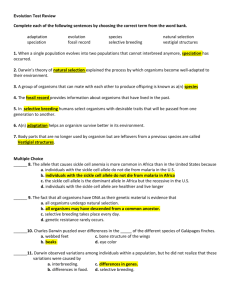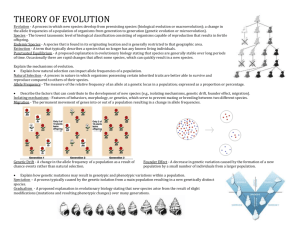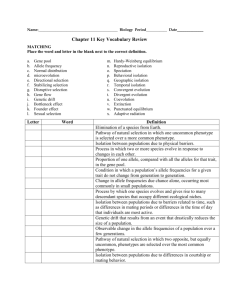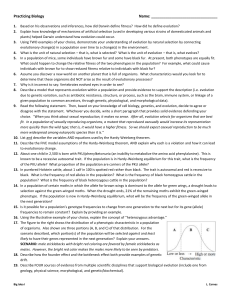SUPERCONDENSED CHAPTER 16-17 REVIEW BIOLOGY CH16
advertisement
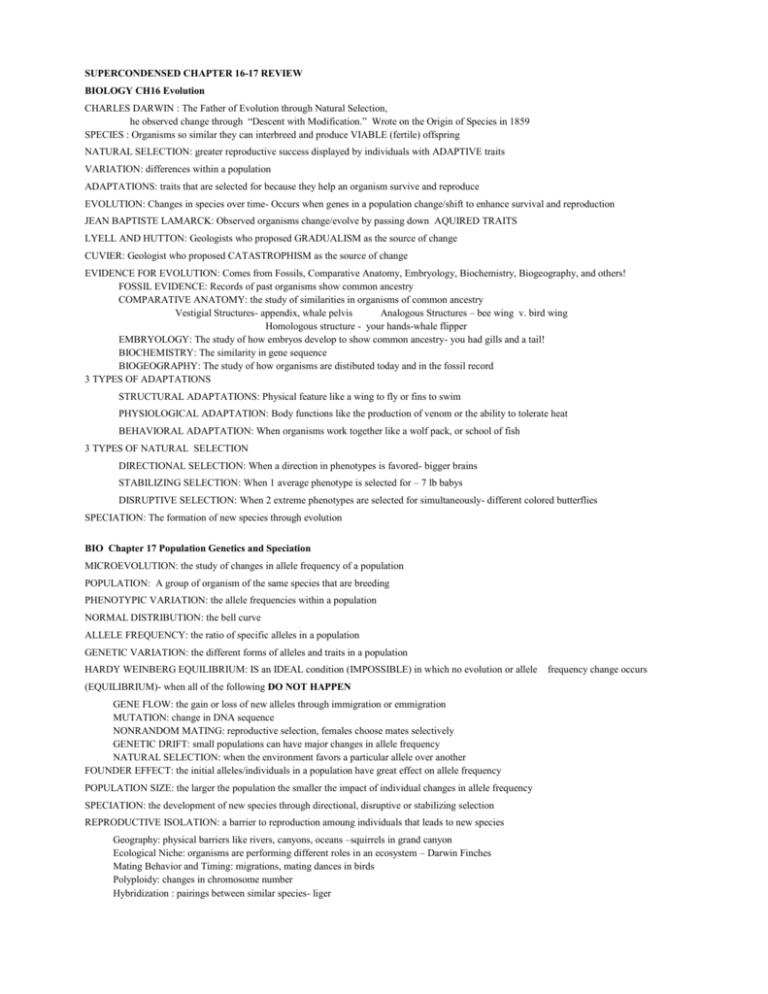
SUPERCONDENSED CHAPTER 16-17 REVIEW BIOLOGY CH16 Evolution CHARLES DARWIN : The Father of Evolution through Natural Selection, he observed change through “Descent with Modification.” Wrote on the Origin of Species in 1859 SPECIES : Organisms so similar they can interbreed and produce VIABLE (fertile) offspring NATURAL SELECTION: greater reproductive success displayed by individuals with ADAPTIVE traits VARIATION: differences within a population ADAPTATIONS: traits that are selected for because they help an organism survive and reproduce EVOLUTION: Changes in species over time- Occurs when genes in a population change/shift to enhance survival and reproduction JEAN BAPTISTE LAMARCK: Observed organisms change/evolve by passing down AQUIRED TRAITS LYELL AND HUTTON: Geologists who proposed GRADUALISM as the source of change CUVIER: Geologist who proposed CATASTROPHISM as the source of change EVIDENCE FOR EVOLUTION: Comes from Fossils, Comparative Anatomy, Embryology, Biochemistry, Biogeography, and others! FOSSIL EVIDENCE: Records of past organisms show common ancestry COMPARATIVE ANATOMY: the study of similarities in organisms of common ancestry Vestigial Structures- appendix, whale pelvis Analogous Structures – bee wing v. bird wing Homologous structure - your hands-whale flipper EMBRYOLOGY: The study of how embryos develop to show common ancestry- you had gills and a tail! BIOCHEMISTRY: The similarity in gene sequence BIOGEOGRAPHY: The study of how organisms are distibuted today and in the fossil record 3 TYPES OF ADAPTATIONS STRUCTURAL ADAPTATIONS: Physical feature like a wing to fly or fins to swim PHYSIOLOGICAL ADAPTATION: Body functions like the production of venom or the ability to tolerate heat BEHAVIORAL ADAPTATION: When organisms work together like a wolf pack, or school of fish 3 TYPES OF NATURAL SELECTION DIRECTIONAL SELECTION: When a direction in phenotypes is favored- bigger brains STABILIZING SELECTION: When 1 average phenotype is selected for – 7 lb babys DISRUPTIVE SELECTION: When 2 extreme phenotypes are selected for simultaneously- different colored butterflies SPECIATION: The formation of new species through evolution BIO Chapter 17 Population Genetics and Speciation MICROEVOLUTION: the study of changes in allele frequency of a population POPULATION: A group of organism of the same species that are breeding PHENOTYPIC VARIATION: the allele frequencies within a population NORMAL DISTRIBUTION: the bell curve ALLELE FREQUENCY: the ratio of specific alleles in a population GENETIC VARIATION: the different forms of alleles and traits in a population HARDY WEINBERG EQUILIBRIUM: IS an IDEAL condition (IMPOSSIBLE) in which no evolution or allele (EQUILIBRIUM)- when all of the following DO NOT HAPPEN GENE FLOW: the gain or loss of new alleles through immigration or emmigration MUTATION: change in DNA sequence NONRANDOM MATING: reproductive selection, females choose mates selectively GENETIC DRIFT: small populations can have major changes in allele frequency NATURAL SELECTION: when the environment favors a particular allele over another FOUNDER EFFECT: the initial alleles/individuals in a population have great effect on allele frequency POPULATION SIZE: the larger the population the smaller the impact of individual changes in allele frequency SPECIATION: the development of new species through directional, disruptive or stabilizing selection REPRODUCTIVE ISOLATION: a barrier to reproduction amoung individuals that leads to new species Geography: physical barriers like rivers, canyons, oceans –squirrels in grand canyon Ecological Niche: organisms are performing different roles in an ecosystem – Darwin Finches Mating Behavior and Timing: migrations, mating dances in birds Polyploidy: changes in chromosome number Hybridization : pairings between similar species- liger frequency change occurs BIOLOGY CH16 -17 REVIEW Types of Natural Selection and Evolution NAME________________________ Identify the type of natural selection – stabilizing, directional, or disruptive. 1. The peppered moth becomes lighter in color over time. ____________________ 2. Giraffe necks become longer. __________________ 3. Most human males are between 5’7” and 6’2”. _____________________ 4. Poison dart frogs appear as either a bright orange or a bright blue. ____________ 5. Whales have become larger in size over time. _________________ 6. Shell color of limpets are pure white or dark tan. _______________ 7. Most small anoles lizards are between 3 and 6 inches long. _________________ 8. Anteaters’ tongues have gotten progressively longer over time. ______________ Identify the pattern of microevolution – mutations, genetic drift, gene flow, random mating, natural selection 1. By chance, only the red flowers were pollinated by bees, so only red flowers show up in the next generation. 2. Due to a change in a base in the DNA code, a new color appears in the wings of local moths. 3. Female marine iguanas will only mate with males who bob their heads. 4. When large seeds are available, birds with large beaks survive and reproduce more often than birds with small beaks. 5. A rabbit with brown fur moves into a region where there are only gray rabbits. 6. Due to a lack of available food, only the small marine iguanas survive and pass on their genes. 7. The base adenine is replaced with guanine, resulting in a new enzyme that allows the organism to digest more meat. 8. A storm blows a group of yellow finches into an area where there were only brown finches previously. 9. The female bird-of-paradise will only mate with the male who dances in a certain way for her. 10. For unknown reasons, only the black mice mated in the spring, so no white mice were seen in the following months. Identify the pattern of macroevolution – coevolution, convergent evolution, or divergent evolution. 1. Sharks and porpoises have the same fin formations. __________________ 2. Primitive flatworms evolved into jellyfish and parasitic roundworms. ________________ 3. Moth-pollinated plants often have spurs or tubes the exact length of a certain moth’s “tongue.” ________________ 4. Birds and bats both have wings for flight. ____________________ 5. Primitive algae split into gymnosperms and angiosperms. ________________ 6. Songbirds have evolved different beaks for seed-eaters and worm-eaters. __________________ 7. 20 species of Honeycreepers in Hawaii have evolved to feed on different diets. ___________________ 8. Acacias trees have large, hollow thorns in which ants live. On the tips of its leaflets, the plant makes a substance used by the ants as food. The ants defend the tree from herbivores by attacking/stinging any animal that even accidentally brushes up against the plant, and prune off seedlings of any other plants that sprout under “their” tree. ____________________
